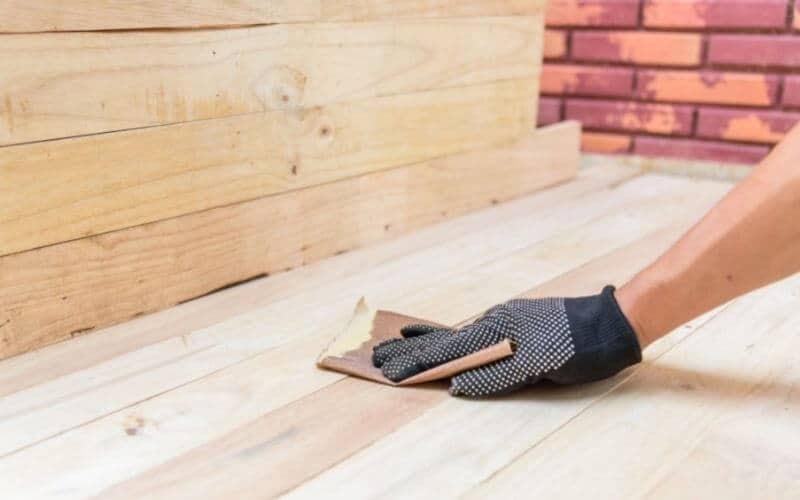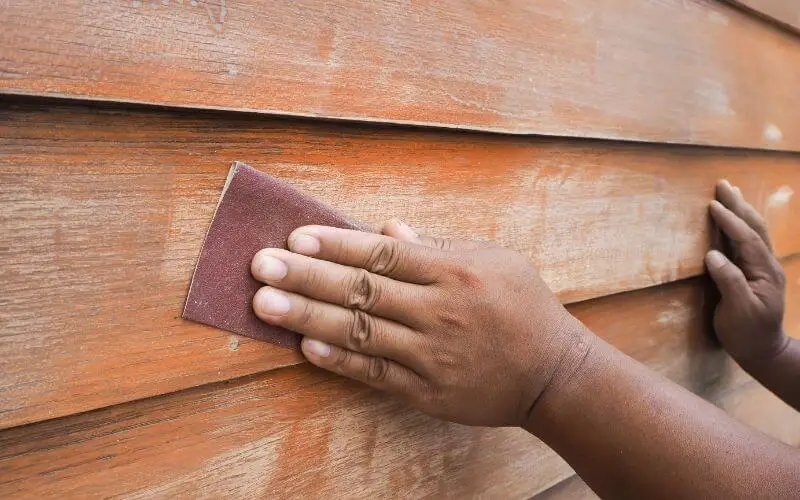Polyurethane is used to give wood floors or furniture a durable finish with a high gloss effect. It could be oil-based or water-based.
Oil-based polyurethanes do not mix with water and resist the effect of alcohol or acids but it turns yellow as it ages. On the other hand, water-based polyurethanes do not resist the influence of alcohol and acids, they also give a softer finish and stays clear as it ages.
Polyurethanes are generally very durable but you may need to know how to remove polyurethane from wood when they wear out or you are seeking to change your wood’s finish.
You can remove polyurethane from wood using vinegar by following the detailed steps in the article. Alternatively, using chemical paint does a great job, simply follow the instructions laid out in the article.
Read: How to stain hardwood floor
How to Remove Polyurethane from Wood
Table of Contents
Using Vinegar
Materials needed for this method;
- Stove
- Water
- Two cups of cornstarch
- Bucket
- Baking soda
- Vinegar
- Paintbrush or cloth
- Stripping pads or wire brushes
- 60 grit sandpaper and 120 grit sandpaper.
To create the mixture, start by boiling some water on a stovetop. Then make a cornstarch paste by mixing a cup of cornstarch with ½ cup of cold water.
In a bucket add four cups of boiled water as well as ¾ cup of baking soda and 1 tbsp. of the vinegar then stir the mixture together. Add this mixture to the cornstarch paste.
Next, use a cloth or a paintbrush to cover your furniture with the mixture then allow the mixture to sit for a couple of minutes.
Use wire brushes or 3M heavy-duty stripping pads to scrub your wood. You’ll know you have removed polyurethane when the wood no longer feels slick.
Scrubbing your wood with stripping pads isn’t overly necessary and you can skip this step and go ahead to sand the wood. However, scrubbing can make the sanding process a lot easier and quicker.
If you do not scrub the wood, you will need to ensure that the mixture is dry to the touch before sanding. Make use of 60 grit sandpaper to sand the wood until you notice the difference in color and the natural wood is revealed.
Next, use 80 grit sandpaper to smoothen the furniture. The higher the grit of sandpaper you make use of, the more the smoothness of your wood. It will also save you time to use higher grits. You can also make use of 120 grit sandpaper to achieve your desired smoothness.
Finally, wipe the floor surface to remove any remaining sawdust to prep your wood for refinishing.
This method does not make use of harsh chemicals but they can help to get the job done faster but to the detriment of your health. Using a natural solution also helps to avoid skin burns and inhalation of toxic fumes.
Read: Can engineered wood floor be refinished
Using Chemical Paint
If you’re comfortable working with chemicals and more comprehensive tools, you can use chemical paint to remove polyurethane from your wood without stress.
For this method, you will need the following;
- Paintbrush
- Bucket
- Water
- safety goggles
- grit sandpaper
- rags or cloths
- chemical paint
- varnish stripper
- 120 and 220 grit sandpaper
- oscillating tool equipped with a hook and loop pad accessory
- 3-inch scraper.
Step 1: Assemble Equipment
Safety first so ensure you are well covered with your protective gear and assemble the equipment you need to use. Ensure to handle the varnish stripper and chemical paint according to the product’s instructions.
Step 2: Apply Stripper
When stripping off the finish from wood, work on a small section at a time. This is to enable you to remove the finish completely from each section before moving onto the next. The varnish stripper should be thick enough to set without drying out within a short time. Apply the stripper with a brush and wait for about 10 minutes.
Read: How to strip and wax a floor
Step 3: Scrape
Using a putty knife or a plastic scraper, scrape the area. The use of plastic will decrease the chances of accidentally damaging the wood. When the polyurethane has softened, you can remove it with a cloth or rag.
Dampen a clean cloth with water and use it to clean the area. Ensure to apply the chemical stripper according to instructions and wipe the area clean with a dry cloth.
Step 4: Brush
Next, apply a generous amount of the chemical stripper and brush in an opposite direction to when it was previously stripped and allow it to sit for about 10 minutes. Scrap and wipe afterward.
Step 5: Sand
With your oscillating tool equipped with a hook and loop pad accessory, fit a 120 grit sandpaper to the tool and use it to smoothen the wood.
As stated earlier, sandpaper with larger grits gives better smoothening, so using 220 grit sandpaper will help to completely smoothen the wood. For best results, the stripper wood should be completely dry before sanding. Then apply desired new stain or finish.
Related: How to sand hardwood floors
Will Mineral Spirits Remove Polyurethane?
Mineral spirits do not affect polyurethane. A paint stripper thinned with solvent (rejuvenate) is better. A rejuvenator will soften the polyurethane and make it easy to wipe off the top material. However, the finish must be stripped to revive it.
Read: How long does polyurethane take to cure?
What Home Remedy Removes Paint From Wood?
You will need a lot of patience and, of course, denatured alcohol, a clean rag, and a woodshop environment to remove latex paint without damaging your furniture. You will need mineral spirits for oil-based spatters, so a lot of care is needed to saturate the wood with the spirit before wiping thoroughly with clean water. Then allow the wood to dry properly.
Read: How to refinish pine floor
Conclusion
There is always a method of removing polyurethane from wood that suits your needs and available resource. Vinegar is an acid that can be used to remove finishes and it’s usually readily available, however, you should only use white vinegar diluted with water on soft floors finished with oil-based coatings.
The steps involved in how to remove polyurethane from wood have been explained in this article. It is always advised that you put safety first in whatever method you find suitable.

